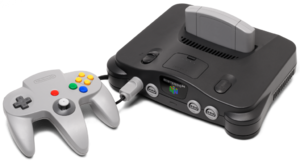Be sure to read our policy on citing sources before editing!
Difference between revisions of "Nintendo 64"
(removed another line) |
(fixed file embed) |
||
| Line 1: | Line 1: | ||
{{Infobox console | {{Infobox console | ||
|image = Nintendo 64 console.png | |image = [[File:Nintendo 64 console.png|300px]] | ||
| | |||
|gen = Fifth generation | |gen = Fifth generation | ||
|released = [[wikipedia:Japan|Japan]]: June 23, 1996<br>[[wikipedia:North America|North America]]: September 29, 1996<br>[[wikipedia:Europe|Europe]]: March 1, 1997 | |released = [[wikipedia:Japan|Japan]]: June 23, 1996<br>[[wikipedia:North America|North America]]: September 29, 1996<br>[[wikipedia:Europe|Europe]]: March 1, 1997 | ||
Revision as of 04:35, December 10, 2018

| |
| Manufacturer | Unknown edit |
|---|---|
| Generation | Fifth generation |
| Release date | Japan: June 23, 1996 North America: September 29, 1996 Europe: March 1, 1997 |
The Nintendo 64 is a home console manufactured and released by Nintendo. Their former second-party developer, Rareware, developed many games for this console, including the first two Banjo-Kazooie series titles, Banjo-Kazooie and Banjo-Tooie. However, Banjo first appeared in another Nintendo 64 game, Diddy Kong Racing, from where the Banjo-Kazoooie franchise spun off from.
In-game appearances
Rare would often include references, cameos, and emblems of or relating to the Nintendo 64 in their games.
In Banjo-Tooie, a Nintendo 64 unit is shown on a table for the file select menu. In the Xbox Live Arcade port, the N logo was removed for copyright-related reasons. If the player selects it, they can enter the Multiplayer mode. The in-game unit would also reflect whether the player connected any additional controllers to the actual unit.
In Banjo-Kazooie: Nuts & Bolts, during the introduction story when Kazooie was playing with her Xbox 360, one can notice a prop beside the television resembling a dusty Nintendo 64. Its controller wires were wrapped around the middle, most likely to obscure the centered Nintendo 64 logo.